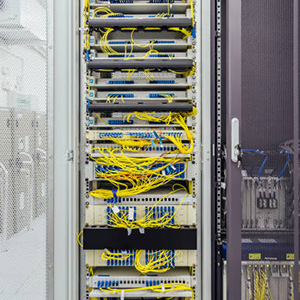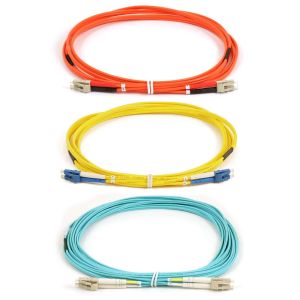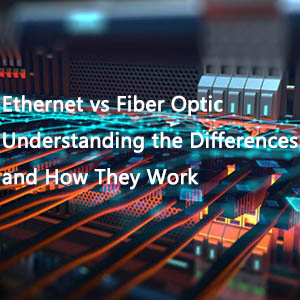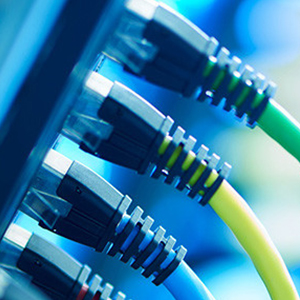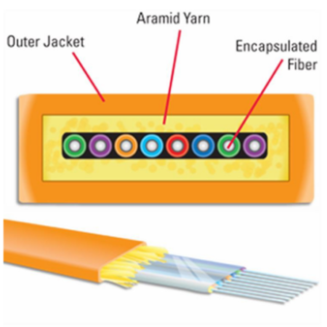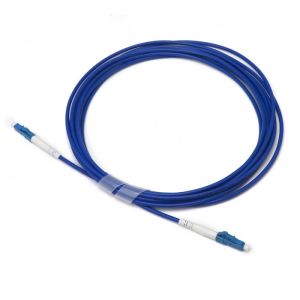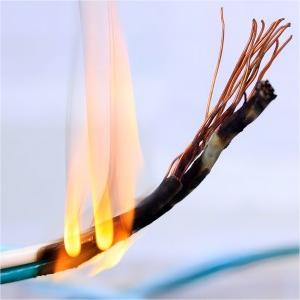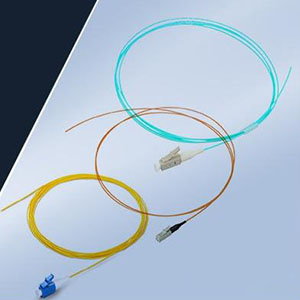Fiber optic technology is rapidly transforming our communication methods. Whether it’s high-speed data centers, complex telecommunication networks, or demanding industrial applications, fiber optic connectors have earned widespread acclaim for their superior performance and efficient transmission capabilities. However, have you ever felt confused when choosing fiber optic connectors, unsure of which type to select? As a professional fiber optic manufacturer, FiberLife understands the various challenges customers face when selecting MPO connectors. To help users solve this problem, we have meticulously compiled a comprehensive comparison guide on 12 Fiber MPO and other types of MPO connectors. Through this guide, you will fully understand the technical characteristics and application scenarios of various MPO connectors, enabling you to make the best choice for your needs.
Basic Concepts of MPO Connectors
Definition and Structure of MPO Connectors
MPO (Multi-Fiber Push On) connectors are a type of multi-fiber connector designed for high-density fiber optic connections. Its core structure includes a multi-fiber array and a plug, achieving rapid connection through a push-pull mechanism. MPO connectors typically consist of multiple fibers arranged in a matrix, which, through precise mechanical alignment, realize multi-channel optical signal transmission.
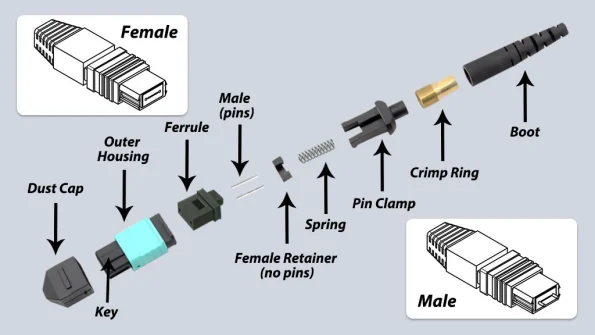
Types of MPO Connectors
MPO connectors can be categorized into several types based on the number of fibers, including 12 Fiber MPO, 24 Fiber MPO, 36 Fiber MPO, and others. Each type differs in fiber count, transmission performance, and application scenarios. We will mainly compare 12 Fiber MPO with 24 Fiber MPO while also briefly introducing other types of MPO connectors.

Characteristics of 12 Fiber MPO Connectors
Technical Specifications
12 Fiber MPO connectors contain 12 fibers and are suitable for high-density connection needs. Key technical specifications include insertion loss, typically within 0.35 dB, ensuring low signal loss. Return loss usually exceeds 20 dB, ensuring high-quality signal transmission. Additionally, their compact size and structure take up minimal space, making them ideal for high-density cabling.

Application Scenarios
12 Fiber MPO connectors are widely used in data centers and telecom equipment, especially suited for high-density cabling needs. They can achieve multi-channel optical signal transmission within a limited space, significantly improving cabling efficiency and transmission performance.
Advantages
12 Fiber MPO connectors boast high transmission performance with low insertion loss and high return loss, ensuring high-quality signal transmission. Their compact design maximizes space utilization, making them ideal for high-density environments. Furthermore, the pre-terminated design of 12 Fiber MPO connectors allows for quick and easy installation, significantly reducing installation time and costs while also lowering maintenance costs. This is particularly crucial for network environments that require frequent changes and expansions.
Characteristics of 24 Fiber MPO Connectors
Technical Specifications
24 Fiber MPO connectors contain 24 fibers, catering to even higher density connection needs. Key technical specifications include insertion loss, typically within 0.5 dB, slightly higher than that of 12 Fiber MPO. Return loss usually exceeds 20 dB, ensuring high-quality signal transmission. Although they are slightly larger in size, they offer higher connection density.

Application Scenarios
24 Fiber MPO connectors are often used in scenarios requiring ultra-high density connections, such as large data centers and telecom stations. By reducing the number of connectors, 24 Fiber MPO can simplify cabling management, improving space utilization and cabling efficiency. In such environments, 24 Fiber MPO connectors can effectively reduce cabling complexity and space occupation, making overall network management more straightforward.
Advantages and Disadvantages
The main advantage of 24 Fiber MPO connectors lies in their ability to provide higher connection density by accommodating more fibers within the same volume, thereby reducing the number of required connectors, simplifying cabling management, and improving overall space utilization. However, 24 Fiber MPO connectors also have some disadvantages, such as relatively higher insertion loss leading to increased signal loss and a slightly larger size which may be less flexible in certain compact environments. Additionally, the higher cost of 24 Fiber MPO connectors can limit their use in budget-constrained projects.
Characteristics of Other Types of MPO Connectors
Common Other Types
In addition to 12 Fiber and 24 Fiber MPO connectors, there are other types of MPO connectors, such as 8 Fiber MPO, 16 Fiber MPO, and 36 Fiber MPO. These connectors differ in fiber count and application scenarios. 8 Fiber MPO connectors are usually used for lower density connection needs, with the advantage of relatively lower cost, making them suitable for budget-constrained small network environments. They also offer superior insertion and return loss performance, meeting general high-speed data transmission needs. 16 Fiber MPO connectors are intermediate between 12 Fiber and 24 Fiber MPO, suitable for medium-density connection needs. They perform well in both transmission performance and connection density, making them suitable for medium to large data centers and telecom stations. 36 Fiber MPO connectors represent the highest density connection needs, containing 36 fibers and suitable for ultra-high-density connection scenarios. Although their insertion and return loss performance may decrease with the increase in fiber count, they can still meet high-speed data transmission needs with reasonable design and optimization.
Detailed Comparison of 12 Fiber MPO and Other Types of MPO Connectors
Performance Comparison
In terms of performance, 12 Fiber MPO connectors have obvious advantages over other types of MPO connectors. The insertion loss of 12 Fiber MPO connectors is typically within 0.35 dB, while that of 24 Fiber MPO connectors is slightly higher, about 0.5 dB. Nevertheless, 24 Fiber MPO connectors still provide sufficient transmission performance in most application scenarios. Regarding return loss, both 12 Fiber MPO and 24 Fiber MPO connectors can achieve over 20 dB, ensuring high-quality signal transmission. Other types of MPO connectors, such as 8 Fiber and 16 Fiber MPO, generally have similar performance to 12 Fiber MPO, though they may perform slightly differently in certain specific applications.
Cost Comparison
In terms of cost, 12 Fiber MPO connectors are relatively lower in cost, suitable for budget-constrained projects. The cost of 24 Fiber MPO connectors increases with the fiber count. However, in high-density connection scenarios, 24 Fiber MPO connectors can reduce overall cabling costs by reducing the number of connectors and simplifying cabling management. Other types of MPO connectors, such as 8 Fiber MPO, have the lowest cost, making them suitable for small networks and general application environments.
Compatibility
In terms of compatibility, 12 Fiber MPO connectors have good compatibility with existing equipment and systems, widely used in data centers and telecom stations. 24 Fiber MPO connectors also have good compatibility, especially in scenarios requiring high-density connections. Other types of MPO connectors, such as 8 Fiber and 16 Fiber MPO, are more suitable for specific application needs.
Flexibility
In terms of flexibility, 12 Fiber MPO connectors are highly flexible due to their compact structure and easy installation, suitable for various complex cabling environments. Although 24 Fiber MPO connectors are slightly larger, their high-density connection advantage makes them excellent for network environments requiring frequent changes and expansions. Other types of MPO connectors, such as 8 Fiber and 16 Fiber MPO, also have their flexibility advantages, suitable for different application scenarios.
Summary and Recommendation
In conclusion, 12 Fiber MPO and other types of MPO connectors each have their unique advantages and application scenarios. When choosing the right MPO connector, you should comprehensively consider specific application needs, budget, and cabling environment. For general high-density connection needs, 12 Fiber MPO connectors are an ideal choice due to their lower cost and excellent performance. In scenarios requiring higher connection density and simplified cabling management, 24 Fiber MPO connectors have significant advantages.
As a leading fiber optic manufacturer, FiberLife understands the diverse needs of customers. We offer MTP/MPO trunk cables ranging from 12 to 144 fibers, supporting both single-mode and multi-mode in 12 and 24 fiber designs. These trunk cable assemblies are made of high-quality LSZH jacketed fiber optic cables, perfectly connecting equipment in racks to MTP/MPO trunk cables. All FiberLife cables are pre-terminated, tested, and packaged before leaving the factory, and come with detailed test reports. Additionally, we provide cable length customization services to meet your various project needs. Whether it’s 40G/100G MTP/MPO cable solutions or other MPO/MTP trunk cables, FiberLife can offer you the perfect choice.
Act now and purchase high-quality MPO/MTP trunk cables from FiberLife to experience excellent connection performance and reliable transmission efficiency! FiberLife is not only your supplier but also your partner in fiber optic connection solutions. Visit our website immediately to learn more details and make your purchase!

